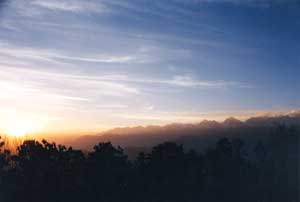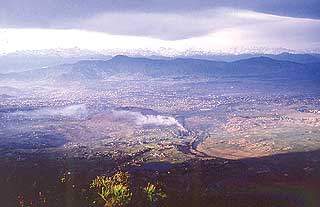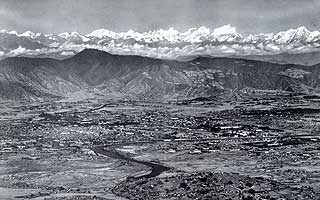 As the eastern sky turns from grey to pink, silhouetting the mountains and framing the sky, a few early risers are huffing and puffing along the pine ridge. They are racing the sun to the top of Champadevi on Kathmandu Valley's southern rim.
As the eastern sky turns from grey to pink, silhouetting the mountains and framing the sky, a few early risers are huffing and puffing along the pine ridge. They are racing the sun to the top of Champadevi on Kathmandu Valley's southern rim.
But the sun is rising at the speed of the earth's rotation, and pretty soon the first rays catch up with the climbers and bathe the dew-wet pine forest in a warm golden glow. Below, the scene is primordial, the fog covering Kathmandu like a blanket at the exact height of the lake that was once there. Only the temple at the top of Kirtipur and Swoyambhu's golden stupa pierce through the mist like islands.
To the north, the snow pyramids of Dorje Lakpa and Langtang reflect the yellow light and loom over the Valley. Along the horizon, dwarfed by the saw-tooth summits of the nearer Rolwaling mountains, is Mt Everest. You'll miss it if you don't know where to look, but the bhadgaonle topi outline of the world's highest mountain is unmistakable. Gauri Shankar's imposing west face is in shadow and despite being more than 100 km away, it has a dominating presence. Welcome to Kathmandu's best-kept secret: The Champadevi Sunrise.
Start early. If lethargy or hangover conspire to keep you in bed, persevere. This time of year, 5.00AM is a good time to start off, because the sun rises early and your progress along the Dakshinkali Road will be slowed by fog. By the time you pass Chobhar, the fog will be as thick as pea soup, mixed up with the overnight dust from the cement factory smokestack. But as the car climbs up the hill, you break through the mist to be accosted by a sky full of stars. Venus is rising behind Phulchowki, just beginning to be visible in the pale pre-dawn to the east. Take the turnoff to Hattiban Resort, and climb the narrow, steep, serpentine bends through pine forests. Pass the resort and drive up another kilometre along the ridge and park the car. The smell of fresh air after the stale air of the Valley floor is so intense that the oxygen makes you dizzy.
The climb to Champadevi should take one-and-a-half hours, and the last bit to the round and wide summit at 6,200 ft is steep. The more adventurous can continue along the ridge and climb another two hours to the summit of Chandragiri at 8,700 ft, from where the views of the Himalaya from Dhaulagiri to Everest are even more spectacular. The great thing about this hike is you can just keep walking along the ridge for as long as you can take it. Some hike right up to Chitlang Pass and descend to Thankot, but this will take you the whole day. Unlike other tourist areas around the Valley, there are no resorts, and the likelihood of seeing other hikers is minimal.
Take plenty of water, there are no streams or water sources. One great way to finish off your Champadevi climb is to make a leisurely descent to Hattiban Resort (keeping an eye out for the abundant bird life), order brunch and stay around for tea while watching the haze clear from Kathmandu Valley laid out at your feet.


View from Champadevi in 1956 (left), and in 2000, with the built-up town and the plume of the Chobhar cement factory in the foreground.


